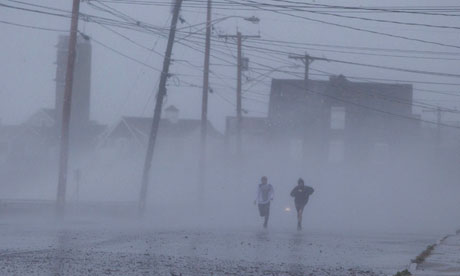
If North Atlantic
hurricanes are more destructive or more frequent, it may be linked to
lower levels of atmospheric pollution. Photograph: Scott Eisen/Reuters
Scientists from Britain's Meteorological Office have fingered a new suspect in their attempt to solve the mystery of tropical storms. It is, unexpectedly, air quality.
If North Atlantic hurricanes are more destructive or more frequent, it may be linked to lower levels of atmospheric pollution. Conversely, sulphate aerosols and other particles from factory chimneys, vehicle exhausts, domestic fires, power stations and other human economic advances may have played a role in keeping tropical storms under control, at least a little, during the 20th century.
Climate scientist Nick Dunstone and fellow-researchers at the Met Office's Hadley Centre in Exeter, Devon, report in the Nature Geoscience journal there is at least circumstantial evidence that aerosols play a more significant role in the storm cycle than anyone had expected.
The reason it has been difficult to separate the effect is a simple one: when humans burn fossil fuels, they release greenhouse gases that slowly but inexorably warm the atmosphere, and therefore the oceans. Atmosphere and ocean are together a climate system: put more energy in, and it must go somewhere. The likely consequences, most people have thought, are extremes of wind and rain.
However, for most of the 20th century, humans released greenhouse gases and also all sorts of other waste at the same time: specifically, sulphate aerosols that, as urban smog, darkened buildings, increased the acidity of the falling rain, rotted limestone structures and condemned hundreds of thousands to bronchial illnesses and, ultimately, to early graves.
It didn't seem possible to separate the effects – at least, not until Britain, western European nations and North America introduced increasingly strict clean air legislation.
This started to give scientists and climate modellers a chance to tease out the different effects of the two pollutants. Aerosols are important absorbers of sunlight, and they are also important in cloud chemistry – water vapour droplets have to condense on something. But important in what way? Do clouds reflect sunlight and cool the region? Or do they build up prodigious quantities of moving water and turn into the frenzies of a tropical storm? Or, overall, do sulphates cool the atmosphere a little and counteract global warming − and, if so, under what conditions?
Read More Here

No comments:
Post a Comment
Hello and thank you for visiting my blog. Please share your thoughts and leave a comment :)